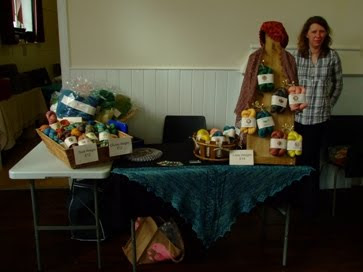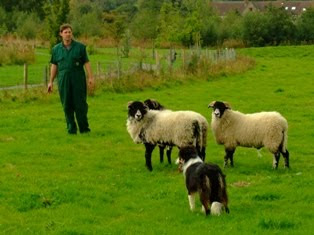Well it looks like my plan to keep a regular blog has gone awry over the past month and a bit. I am now going to buckle down and try and post regularly so to start off with here is a quick recap of everything woolly that has gone on since my last posts.
Trouser Tasting Teeswater Twins.

Late August we went off for a visit to Highside Farm in Teesdale. We had previously bought one of their Teeswater fleeces via the sale at Woolfest and were visiting to see their sheep and look at the few fleeces they still had. Richard and Stephanie Proud who run the farm have developed a model of diversification keeping rare breed pigs, shorthorncattle and free range chickens as well as sheep and also run a small campsite on their land.
They are unusual in that they keep a small but extremely mixed flock and actively breed their sheep to produce interesting fleeces. As well as a number of crosses they had black Wensleydale, Gotland as well as a number of Teeswaters.


As they don’t have a working dog the majority of the sheep are trained to be hand tame and readily came upto you. One of the first to greet us was Pogie, whose fleece was the one we bought at Woolfest. While she was well behaved the same could not be said of a pair of hand-reared, late Teeswater lambs, Diddle and Dumpling, whose response to our arrival was to run up and start chewing on my trouser pockets (obviously on the off chance that I had food).
Another great character was Wellie, a young Teeswater ram, who whose ability to pose marked him out as a future star.
 After meeting the sheep we had a look at the fleeces and went away with two part Teeswaters and two Texel cross shearling fleeces. The former we hope to get made up into a low twist 2ply sock-weight for shawls/stoles and the latter we hope to get made into a standard sock as they are reasonably soft but also feel very hardwearing.
After meeting the sheep we had a look at the fleeces and went away with two part Teeswaters and two Texel cross shearling fleeces. The former we hope to get made up into a low twist 2ply sock-weight for shawls/stoles and the latter we hope to get made into a standard sock as they are reasonably soft but also feel very hardwearing.
________________________________
Beside the Sea

The end of August saw us head up the coast to St Abbs for a Bank Holiday festival organised by Louise from Woolfish. Normally she runs two festivals a year in February and November, held in the old school, so this was a new timeslot for the event. We were both excited as this was my first festival-proper and I spent quite some time planning the layout including making a stand to display my lace weights together with a shawl knitted in Red Grape Silky lace.
Typically once there I found that I had completely miscalculated on what would fit in my space but luckily the organiser was kind enough to supply another table (Thanks Louise!!!).

The show was quieter than normal but we still sold a number of skeins, especially laceweight (so the stand obviously did its job) and got to chat with lots of enthusiastic yarnies.
So now we are really looking forward to having another stall in November. Lousie is hoping to expand into the newly renovated village hall and possibly run some workshops. If you are in the area it is a great little festival attracting big name indie dyers as well as smaller local firms like myself. Plus if you are going to hold such an event you couldn’t do it in more picturesque surroundings

________________________________
More from the Flexigraze sheep.

Last week saw the return of some of the Flexigraze sheep to Tyne Riverside park. To help develop the wild flower meadow three Manx Loaghtan and seven Swaledales, which I had previously helped shear earlier in the year, were to be moved in from Whittle Dene. After rounding the sheep up Stephen Coomber took them in his truck to the park where we penned them so that their feet could be checked and then the Swales could have their bellies and tails sheared to keep them clean. This involved the volunteers catching and dragging out the sheep for Stephen and boy, they may have been skinny last time we met but the Swales had really put on weight. One of the rangers even got a chance to try shearing herself.

As well as the volunteers, a team from the Local Environmental Action fund that supports Flexigraze were also present to take publicity photos. After lots of fun trying to get the sheep to ‘look at the camera’ Stephen ran Jess, the other half of the Flexigraze team, through her paces to get some action shots of her developing herding skills.

 There was recently a Ravelry thread regarding the substantial walnut tree outside the Knit studio shop in central Newcastle. One customer collected the nut husks and used them to dye a skein of wool a wonderful series of rich browns. This got me thinking about dyeing with other nut husks that are more commonly available in the UK compared to walnut. One obvious choice was the spiky husk that occurs around conkers. Fortunately although it was near the end of autumn a number of husks could still be found around so I was able to collect some for a test dye.
There was recently a Ravelry thread regarding the substantial walnut tree outside the Knit studio shop in central Newcastle. One customer collected the nut husks and used them to dye a skein of wool a wonderful series of rich browns. This got me thinking about dyeing with other nut husks that are more commonly available in the UK compared to walnut. One obvious choice was the spiky husk that occurs around conkers. Fortunately although it was near the end of autumn a number of husks could still be found around so I was able to collect some for a test dye.















































